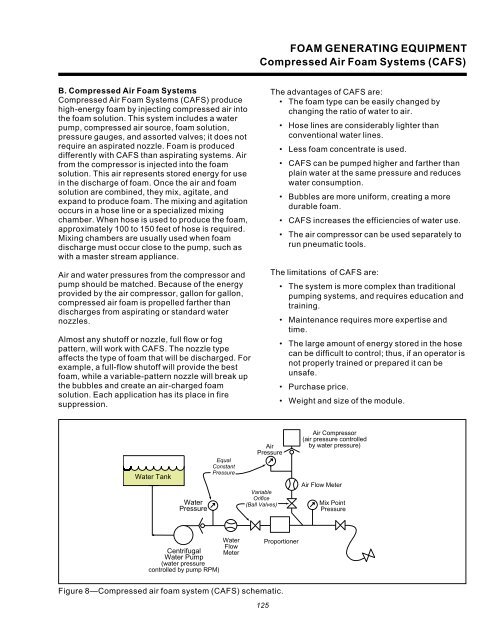Water Handling Equipment Guide - National Wildfire Coordinating ...
Water Handling Equipment Guide - National Wildfire Coordinating ...
Water Handling Equipment Guide - National Wildfire Coordinating ...
Create successful ePaper yourself
Turn your PDF publications into a flip-book with our unique Google optimized e-Paper software.
FOAM GENERATING EQUIPMENT<br />
Compressed Air Foam Systems (CAFS)<br />
B. Compressed Air Foam Systems<br />
Compressed Air Foam Systems (CAFS) produce<br />
high-energy foam by injecting compressed air into<br />
the foam solution. This system includes a water<br />
pump, compressed air source, foam solution,<br />
pressure gauges, and assorted valves; it does not<br />
require an aspirated nozzle. Foam is produced<br />
differently with CAFS than aspirating systems. Air<br />
from the compressor is injected into the foam<br />
solution. This air represents stored energy for use<br />
in the discharge of foam. Once the air and foam<br />
solution are combined, they mix, agitate, and<br />
expand to produce foam. The mixing and agitation<br />
occurs in a hose line or a specialized mixing<br />
chamber. When hose is used to produce the foam,<br />
approximately 100 to 150 feet of hose is required.<br />
Mixing chambers are usually used when foam<br />
discharge must occur close to the pump, such as<br />
with a master stream appliance.<br />
Air and water pressures from the compressor and<br />
pump should be matched. Because of the energy<br />
provided by the air compressor, gallon for gallon,<br />
compressed air foam is propelled farther than<br />
discharges from aspirating or standard water<br />
nozzles.<br />
Almost any shutoff or nozzle, full flow or fog<br />
pattern, will work with CAFS. The nozzle type<br />
affects the type of foam that will be discharged. For<br />
example, a full-flow shutoff will provide the best<br />
foam, while a variable-pattern nozzle will break up<br />
the bubbles and create an air-charged foam<br />
solution. Each application has its place in fire<br />
suppression.<br />
The advantages of CAFS are:<br />
• The foam type can be easily changed by<br />
changing the ratio of water to air.<br />
• Hose lines are considerably lighter than<br />
conventional water lines.<br />
• Less foam concentrate is used.<br />
• CAFS can be pumped higher and farther than<br />
plain water at the same pressure and reduces<br />
water consumption.<br />
• Bubbles are more uniform, creating a more<br />
durable foam.<br />
• CAFS increases the efficiencies of water use.<br />
• The air compressor can be used separately to<br />
run pneumatic tools.<br />
The limitations of CAFS are:<br />
• The system is more complex than traditional<br />
pumping systems, and requires education and<br />
training.<br />
• Maintenance requires more expertise and<br />
time.<br />
• The large amount of energy stored in the hose<br />
can be difficult to control; thus, if an operator is<br />
not properly trained or prepared it can be<br />
unsafe.<br />
• Purchase price.<br />
• Weight and size of the module.<br />
<strong>Water</strong> Tank<br />
<strong>Water</strong><br />
Pressure<br />
Equal<br />
Constant<br />
Pressure<br />
Air<br />
Pressure<br />
Variable<br />
Orifice<br />
(Ball Valves)<br />
Air Compressor<br />
(air pressure controlled<br />
by water pressure)<br />
Air Flow Meter<br />
Mix Point<br />
Pressure<br />
Centrifugal<br />
<strong>Water</strong> Pump<br />
(water pressure<br />
controlled by pump RPM)<br />
<strong>Water</strong><br />
Flow<br />
Meter<br />
Proportioner<br />
Figure 8—Compressed air foam system (CAFS) schematic.<br />
125
















